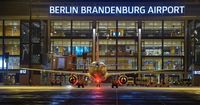On the evening of October 31, 2025, Berlin Brandenburg Airport—Germany’s main international gateway to the capital—found itself at the center of a growing European crisis: drone incursions into restricted airspace. For nearly two hours, all takeoffs and landings were suspended, leaving passengers stranded, flights rerouted, and authorities scrambling to respond to a threat that has become alarmingly familiar across the continent.
The disruption began just after 8 p.m., when a witness reported spotting a drone near the airport’s northern runway. According to a police spokesman, officers in a patrol car soon confirmed the sighting, although they were unable to locate the drone’s operator. The airport’s spokesman told the media that the suspension of operations lasted from 8:08 p.m. to 9:58 p.m. local time, and that a “whole series of flights” were diverted to other German cities during the closure. “We assume that the danger has been averted for the time being,” the spokesman said, as quoted by DW.
Flight schedules quickly became a patchwork of delays and diversions. Departures to Basel, Oslo, and Barcelona were prevented from leaving Berlin, while inbound flights from London, Stockholm, Antalya, and Helsinki were rerouted to alternate airports such as Hamburg, Dresden, Leipzig, and Hanover. Passengers were advised to check their flight statuses with airlines and prepare for the possibility of further delays or cancellations. As one traveler put it, the uncertainty was “stressful and confusing,” especially for those with tight connections or important business meetings.
In a rare move, Berlin’s longstanding ban on night flights was temporarily relaxed to help airlines and passengers recover from the disruption. This decision underscored the seriousness of the situation and the knock-on effects that a single drone can have on an entire region’s air traffic. Authorities deployed a police helicopter and called in Germany’s Federal Aviation Office to assist in the search and response. Despite these efforts, the drone’s pilot was never identified, and the incident ended without an arrest or clear explanation.
While the immediate crisis at Berlin Brandenburg was resolved within two hours, the event is part of a much broader—and increasingly worrisome—trend. In 2025 alone, European airports have repeatedly been forced to suspend operations due to unidentified drones. Just weeks earlier, Munich Airport in southern Germany was closed twice within 24 hours, grounding thousands of passengers after drone sightings. Airports in Denmark, Norway, and Poland have also experienced similar disruptions. According to DW, these incidents are not isolated; rather, they are evidence of a rising tide of unauthorized drone activity across the continent.
German leaders have been vocal about the growing threat. Interior Minister Alexander Dobrindt recently called for Germany to “find new responses to this hybrid threat”—a reference to the complex blend of civilian and potentially hostile drone use that challenges traditional security measures. Dobrindt has advocated for greater capabilities to detect, assess, and, if necessary, shoot down drones that violate restricted airspace.
Why such urgency? The answer, say experts and officials, lies in the evolving security landscape of Europe. Since September 2025, Russia has been accused of regularly violating the airspace of NATO member states with both drones and manned aircraft. According to DW and other outlets, Russian drones and unidentified unmanned aerial vehicles (UAVs) have been detected over Poland, Romania, Estonia, Denmark, Spain, Latvia, France, Germany, and beyond. While Moscow has dismissed many of these allegations, the pattern has left European governments on edge.
The situation has prompted not only national responses but also coordinated action at the European level. In October 2025, the European Parliament adopted a resolution urging EU member states to shoot down drones and aircraft that illegally violate their airspace. This follows a call from U.S. President Donald Trump, who, during a press conference with Ukrainian President Volodymyr Zelenskyy in New York, said that NATO countries should “shoot down Russian aircraft that enter their airspace.” The rhetoric may be heated, but the underlying concern is real: drones, whether used for surveillance, disruption, or worse, represent a new kind of threat that traditional air defense systems are not always equipped to handle.
For airports, the challenge is both technical and operational. Drones are banned within a 1.5-kilometer radius of German airports, a rule designed to prevent interference with takeoffs and landings. Violations are considered dangerous and can result in severe penalties. Yet enforcement is difficult. As the Berlin incident shows, even with rapid police response and aerial surveillance, locating and neutralizing a drone operator is far from straightforward.
In response, airports across Europe are investing in new technologies to detect and counter drones. The European Union Aviation Safety Agency (EASA) has issued repeated warnings about the risks posed by UAVs in restricted airspace, and many airports are implementing anti-drone systems that can jam signals or even physically intercept rogue devices. Still, as drone technology evolves and becomes more accessible, the race between security measures and potential threats continues.
The human cost of these incidents is not lost on travelers. Business passengers miss meetings, tourists lose precious vacation time, and airlines face mounting costs from delays and rerouted flights. As one airport official told dpa, “Every minute of closure has a ripple effect—we do everything we can to minimize disruption, but safety comes first.”
For Berlin Brandenburg Airport, the October 31 shutdown was not the first of its kind. Just two days earlier, on October 29, the airport was also closed after a drone detection. The frequency of such events has led to calls for even stricter regulations and closer international cooperation. Some officials argue that only a united European approach can adequately address the cross-border nature of the drone threat.
As the dust settles from the latest incident, one thing is clear: drone-related disruptions are no longer rare exceptions but part of the new normal in European air travel. Whether the challenge comes from hobbyists, criminals, or geopolitical adversaries, airports and authorities must remain vigilant and adaptable. For passengers, the best advice is to stay informed, check flight statuses, and be prepared for the unexpected. The future of air travel may be more secure, but it is unlikely to be less complicated.
While the skies over Berlin are once again open, the specter of drones—and the questions they raise about security, technology, and international relations—remains ever-present.


